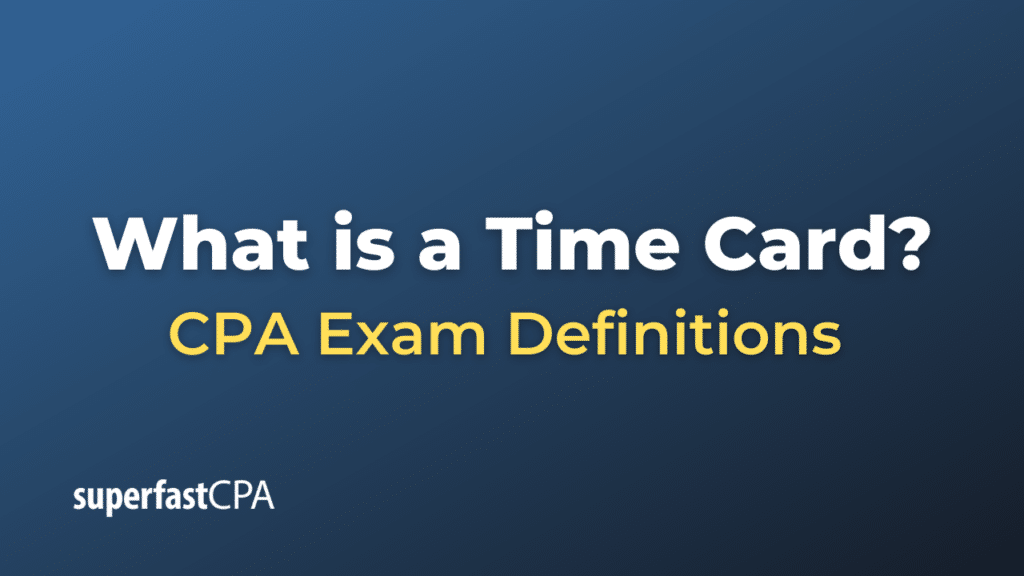Time Card
A time card, also known as a punch card or clock card, is a physical or digital record used by workers to track the number of hours they have worked during a particular period. Traditionally, time cards were physical cards that workers inserted into a time clock, which would then stamp or punch the start and end times of the worker’s shift. With advancements in technology, many businesses have transitioned to digital or electronic timekeeping systems, though the principle remains the same.
Features of a Time Card:
- Employee Information: Typically includes the employee’s name, ID number, and sometimes their job title or department.
- Date: The specific day or week the time card represents.
- Start and End Times: When the employee clocked in and clocked out each day.
- Total Hours Worked: Often broken down by regular hours, overtime hours, and any other categories relevant to the employer’s compensation structure.
- Breaks or Lunch: Some time cards have sections for employees to mark when they take lunch or other breaks.
- Signatures or Approvals: Some systems require a manager’s signature or approval to verify the hours worked.
Example of Using a Time Card:
Let’s say Jane works at a manufacturing facility that still uses a physical time clock. Every day when she arrives at work, she takes her time card (which is stored in a slot next to the time clock) and inserts it. The time clock stamps the current time onto the card. She does this again when she takes her lunch break, when she returns from lunch, and when she leaves for the day. At the end of the week, Jane’s total hours are tallied, and she is paid based on the hours recorded on her time card.
Modern digital systems often simplify this process. For instance, Jane might simply swipe a magnetic card or scan a barcode on her employee badge when she arrives and leaves. Some advanced systems even use biometrics, like fingerprint or facial recognition, to track employee hours. Regardless of the method, the purpose of a time card remains consistent: to record the hours an employee has worked.
Example of a Time Card
Let’s imagine a scenario with a traditional physical time card system at a local bookstore.
Bookstore Name: “Novel Ideas”
Employee: Lucas Smith
Week of: August 21, 2023 to August 27, 2023
Time Card Details:
| Date | Clock In | Lunch Start | Lunch End | Clock Out | Total Hours |
|---|---|---|---|---|---|
| 21-Aug-23 | 9:00 AM | 1:00 PM | 2:00 PM | 5:00 PM | 7 hrs |
| 22-Aug-23 | 9:15 AM | 1:05 PM | 2:05 PM | 5:00 PM | 6.75 hrs |
| 23-Aug-23 | 9:00 AM | 1:00 PM | 2:00 PM | 5:00 PM | 7 hrs |
| 24-Aug-23 | OFF | — | — | — | 0 hrs |
| 25-Aug-23 | 9:10 AM | 1:10 PM | 2:10 PM | 5:05 PM | 6.9 hrs |
| 26-Aug-23 | 10:00 AM | 2:00 PM | 3:00 PM | 6:00 PM | 7 hrs |
| 27-Aug-23 | OFF | — | — | — | 0 hrs |
Total Hours for the Week: 28.65 hours
At the end of the week, Lucas or his manager would tally up the total hours worked, ensuring that Lucas gets paid for 28.65 hours for that week. They might also use this record to determine if Lucas is eligible for any overtime pay or if there were any discrepancies in his attendance.
This example shows a simple traditional time card, but in many businesses today, this process is automated, with digital systems tracking and calculating hours, making the entire payroll process more efficient and accurate.













